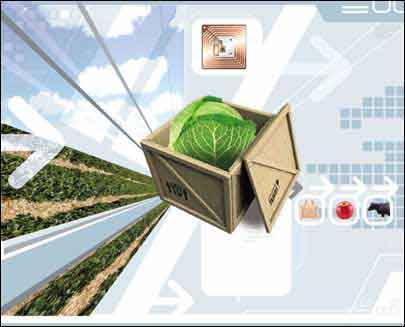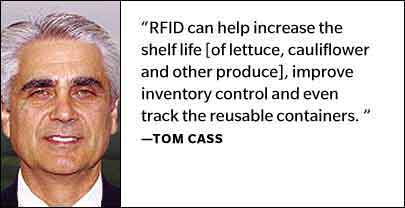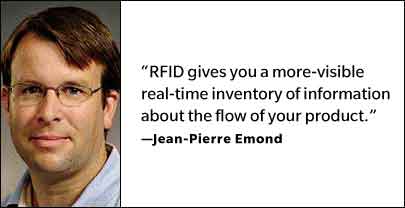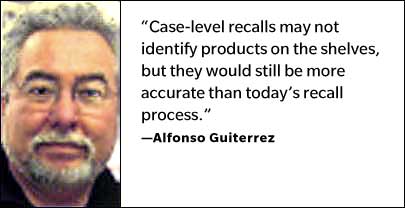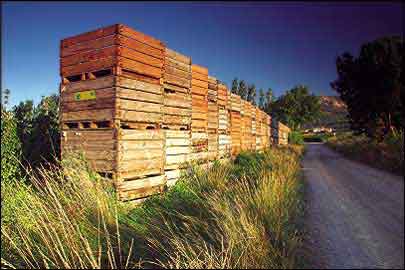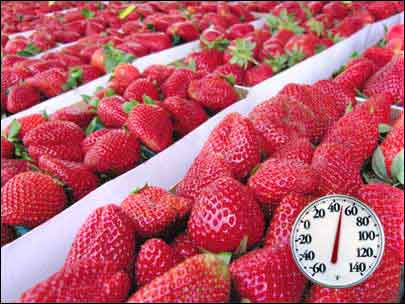In the expansive fields of Salinas, Calif., and Yuma, Ariz., farmworkers cut each head of lettuce, wrap it in a bag and place it in a reusable plastic container that holds 24 heads. They have been following the same process for decades until last year, when the management of Tanimura & Antle (T&A), their employer, added a new step.
After packing a container with lettuce, farmworkers now apply a label with an RFID tag containing a unique Electronic Product Code to the container’s side. Once enough containers are packed to form a pallet, another RFID tag is applied to the pallet.
The RFID tags, provided by a third-party supplier, are already encoded and the labels printed prior to the harvest crews’ use. The EPC numbers of the container and pallet tags are correlated with data identifying the field where the lettuce grew, the crew, the time the heads were picked and which driver took them to the refrigerated warehouse.
At the warehouse, the pallets and containers are unloaded and passed by an RFID interrogator; the tag information is entered into a database. In the past, the first load to arrive at the warehouse was the first to get cooled. Now T&A is using RFID to give priority to cooling the first load cut.
“The faster we can get that product cooled down to 34 to 36 degrees, the longer its shelf life,” says Tom Casas, T&A’s vice president of IT. “For each hour of delay in cooling, you could significantly decrease the shelf life of lettuce.”
In late 2004, T&A volunteered to participate in an RFID pilot run by Wal-Mart, the world’s largest retail chain, which had required its top 100 suppliers to begin tagging pallets and cases of goods in January 2005. T&A isn’t one of Wal-Mart’s top 100 suppliers, but the company sells 34 different products to Wal-Mart and wanted to keep its business.
T&A also believed that RFID could streamline the supply chain. The company has been tagging pallets and containers of lettuce and cauliflower destined for Wal-Mart ever since, and Casas says RFID can help to increase shelf life, improve inventory control and even track the reusable containers.
Produce suppliers around the world have come to the same conclusion. The fresh food supply chain is global in nature, and that means it takes longer than ever for produce to make the trip from the field to the dinner table. During winter months, grapes are imported to the United States from Chile; melons come from Mexico. Lettuce and broccoli grown in California are sold in grocery stores in Asia. U.S.-grown asparagus is served for supper in Switzerland.
Suppliers of many other perishable foods and beverages—including meats, poultry, seafood and dairy products—believe RFID has the potential to dramatically reduce losses from spoilage in the food industry. (To that end, suppliers are interested in pairing RFID with environment sensors; see sidebar at end of article.)
The technology also promises to help producers of perishable foods better track the location of food products in case of recalls due to contamination by pathogens or, possibly, bioterrorists. Given the rising concern about animal-borne illnesses, RFID is being used to track animal products from the source—such as sheep and cattle in Australia, pigs in Spain and Portugal, and shrimp in Thailand.
As companies seek to harness RFID technology, they are facing some challenges. Food and beverage producers with low margins and high turnover say that they are having a hard time finding business justification for the high cost of RFID tags, hardware and software. Beverage, dairy and bakery product companies often rely on distributors to transport their goods to supermarkets and convenience stores, and questions remain about the ownership of data collected via readings of RFID tags. And for foods that contain liquids, the high concentration of water interferes with RFID readings.
Ensuring Peak Freshness
To test whether RFID can improve the distribution of fresh produce, Publix Super Markets, which operates 858 stores in Alabama, Florida, Georgia, South Carolina and Tennessee, is working with three fresh produce suppliers and the University of Florida on a pilot that began late last year. T&A is tagging containers and pallets of cauliflower. Del Monte Fresh Produce of Coral Gables, Fla., is tagging shipments of fresh pineapple, and A. Duda & Sons of Oviedo, Fla., is tagging celery. “Because of our desire to provide the freshest produce possible to our customers, anything that helps improve this segment of our supply chain is critical,” says Maria Brous, a spokesperson for Publix.
“You can’t really slow down the decrease in the product’s shelf life,” says Jean-Pierre Emond, an associate professor of packaging science at the University of Florida’s Institute of Food and Agricultural Sciences, who is supervising the pilot. “But you can control how fast you can move the product. RFID gives you a more-visible real-time inventory of information about the flow of your product.”
That real-time information can help food suppliers better manage inventory in their warehouse, by locating products with the earliest expiration dates to make sure they get shipped out first. In addition, data collected from reading RFID tags along the transportation route can help uncover bottlenecks in the supply chain, such as trucks, distribution centers or warehouses where perishable products sit too long. Suppliers and retailers hope, ultimately, to reduce the shrink—the percentage of products that get lost or go bad before reaching consumers.
Part of the Publix trial involves using the EPCglobal Network to share the data collected about a product or shipment with partners. “The sooner you can get the product to the floor, the better experience the consumer is going to have,” says Dave Silva, director of information systems for the Ballantine Produce Co. of Sanger, Calif., which has been shipping RFID-tagged nectarines to Wal-Mart and peaches to Albertsons, a chain of 2,400 supermarkets in 38 states. The sharing of data during transportation is important. “We don’t want the product sitting in any one of those steps in the supply chain for more time than is necessary,” says Silva.
Companies such as Tyson Foods of Springdale, Ark., believe they will be able to make the most of RFID tagging once the EPCglobal Network is up and running and suppliers and retailers can share information. Tyson, the world’s largest meat company, started adding RFID tags to cases and pallets of some frozen poultry, ground beef and pork and beef tray packs for Wal-Mart at the end of 2004. In the middle of last year, it also started tagging shipments of similar products to Albertson’s.
Tyson has been placing unique serialized bar code numbers on individual items of packaged meats and poultry along with dates, to ensure that the products with earliest expiration dates are shipped out first. But RFID holds the promise of allowing Tyson to share that information with retailers. Before that can happen, standards need to be developed to include date information in EPC codes, and the EPCglobal Network needs to be operational so that the information can be shared electronically.
Right now, Tyson is not realizing any quantifiable return on investment from its RFID tagging operation. But Herbert Markwardt, RFID project lead for Tyson, says he anticipates that the company will eventually realize savings in terms of cutting down on labor, gaining transparency in the supply chain and ultimately reducing product shrink. “A lot of products have a 10-day shelf life, and it can take, just in shipping, two or three days to get there,” Markwardt says. “If not rotated correctly at the store, some products are prone to being pulled from the shelf because of a date issue or being sold [at lower prices] in fire sales.”
Researchers at Agrotechnology & Food Innovations, part of Wageningen University in the Netherlands, have been working with a Dutch retailer, a food processor, a logistics provider and a company that provides reusable crates, which are commonly used to transport fresh foods in Europe. Together, they are creating a pilot in which crates loaded with fresh mixed vegetables will get RFID tags and be distributed from the food processor’s facilities. The goal is to track the crates as they move through the supply chain. The RFID data will reveal how long the vegetables took to move from one point in the chain to another, and help the researchers develop algorithms for determining when to replenish perishables and how much product to put on the shelves.
Protecting the Food Supply
A study released in October by the U.S. Government Accountability Office (GAO), the watchdog arm of Congress, found food recalls are increasing and handled very ineffectively. In 2004, 36 million pounds of meat and poultry were recalled in the United States—more than six times the amount recalled in 1988. Recent recalls have included E. coli contamination of packaged salads, cantaloupe and unpasturized juice. In addition, a growing number of companies have had to pull products off store shelves because they were not labeled properly and contained ingredients that are highly allergenic, such as peanuts. Such recall announcements can be devastating for a company, generating negative publicity, liability lawsuits and damage to the company’s brands.
The GAO looked at 20 food recalls in 2004 and concluded that only 36 percent of agricultural foods and 38 percent of foods regulated by the U.S. Food and Drug Administration (FDA) were recovered. Another study in 2002 at Ohio State University found that only half of the meat and poultry subject to recall in the United States from 1998 to 2002 was ever recovered.
“Today, the technology used in recalling products has a wide margin of error,” says Alfonso Gutierrez, director of the RFID Lab at the University of Wisconsin-Madison. The use of RFID would help companies involved in product recalls locate the tainted goods. Each case and pallet would have a unique EPC number that could be correlated with pertinent data, such as where the food was grown, raised or processed, which retailers it was shipped to, and where it is currently situated in a distribution center, warehouse or store. Case-level recalls may not identify products on the shelves—item-level tracking for recalls is still several years away—but Gutierrez says they would still be more accurate than today’s recall process.
“If we can know exactly what distribution center or store the products went through, we can track by batch or lot number instead of recalling everything that went out,” says Bill Hardgrave, director of the RFID Center at the University of Arkansas. He adds that if tainted batches of food can be tracked more accurately, recalls might cost companies only a few thousand dollars.
RFID tracking of cattle and poultry has the potential to help assure consumers that the products being sold are not from diseased animals. The rise of mad cow disease and avian flu convinced governments around the world to enact regulations and bans to ensure the safety of meat and poultry products. In 2003, after a cow in Washington State was found to have mad cow disease, Japan and a few dozen other countries banned imports of all U.S.-raised beef. The U.S. Department of Agriculture prohibits the importation of beef from Britain, after the outbreak of mad cow disease there in the 1990s. In countries with large cattle populations, such as Australia and New Zealand, ranchers have turned to RFID tagging herds to ensure against the spread of the disease there. The United States now has an animal-tracking program that is technology neutral, but some livestock auction companies, such as Northern Livestock Video Auction, are recommending the industry adopt RFID.
RFID could also help food and beverage manufacturers, processors, distributors and importers maintain better records in compliance with new U.S. government requirements developed after Sept. 11, 2001. Concerns that the nation’s food supply might be targeted for bioterrorism led the FDA to issue a new ruling, slated to go into effect this year, requiring the maintenance of records to protect the supply of human food and animal feed. The rule, which would impact both fresh and packaged foods, will require that records indicate the source of food received and where it was sold.
Unisys worked on an RFID pilot program, partly funded by the U.S. Department of Homeland Security, which used the technology to better secure coffee beans imported from Brazil. The project involved attaching active (battery-powered) RFID tags to seal large burlap bags of coffee beans imported by Sara Lee. “The objective was product integrity and to ensure a secure environment to police the smuggling of drugs or weapons or other things,” says Peter Regen, vice president of global visible commerce at Unisys. In the importation process, every time the bags of coffee passed an RFID interrogator, it would read the seals to ensure that the product had not been tampered with.
Overcoming Challenges
EPCglobal, the nonprofit organization that is commercializing EPC technology, is planning to empanel a work group to address the challenges in implementing RFID in the food industry. John Seaner, senior director of industry development at EPCglobal US, says the focus of the group will be agricultural products, meats and poultry, dairy products and beverages.
One of the biggest challenges Seaner expects the group to address is the role of direct-store delivery of these products by third-party distributors or wholesalers. Any RFID solution that manufacturers undertake would have to include a component that lets these third parties track the products. Questions remain about who would own the data and whether it would be shared with parties through the supply chain.
Seaner says the work group will need to develop standards for products that have variable weights, such as meats. EPC codes currently do not include information about weight. “The issue is how to classify the object when it keeps changing in composition and unit size,” Seaner says. “Think of a chicken that is sold by a food distributor that can be divided into parts at the grocer that can be resold. Not only has the chicken as a whole borne new ‘products’ in the form of thighs, wings, drumsticks, etc., but the weight of each item varies as well. Thus, is each drumstick a new product or just receives a different serial number?”
Companies are also working to surmount some technical challenges, such as getting around the laws of physics to ensure good RFID readings on cases or pallets of beverages or foods with high water content. When Ballantine Produce Co. started tagging cases and pallets of nectarines, which have a high water content, the company found it had to assemble cases with tags facing interrogator antennas in order to read cases on pallets.
Fresh food and beverage companies participating in RFID pilots say that the costs are still high for RFID tags, software and hardware, and the development of new business processes. But they are hopeful that return on investment will come in the form of reducing the amount of product that spoils in the supply chain and avoiding costly recalls.
“I see many different applications for RFID in the food and beverage industry, ranging from anticounterfeiting measures for Scotch to monitoring and tracking frozen foods to tracking reusable totes to Wal-Mart-style supply chain visibility,” says Regen of Unisys. “Some of these are economical today, and all of them will be in the future.”
Sensing Trouble in the Food Supply Chain
Roughly 10 percent of all perishable goods, including food products, becomes unusable before it reaches consumers. Food producers hope that by pairing RFID technology with diagnostic sensors, they can gather information about how the product is handled during transport—including the temperature and humidity levels at which it is kept, and spoilage from bacteria or pathogens, such as salmonella—and use the near real-time data to correct environmental problems.
Retailers also can draw on the information to determine how much shelf life remains for a given product when it arrives at a distribution center. Some products, such as vegetables and ready-to-cook foods, can spoil in a week or two. Transportation to a retail store can take one or two days. If a product is kept at temperatures that are too high or low, shelf life may be further eroded and a retailer may want to reject a shipment.
“Maybe strawberries or meats were kept in a trailer somewhere and the temperature spiked to 87 degrees,” says Bill Hardgrave, director of the RFID Center at the University of Arkansas. “Now a retailer can stop it from even getting unloaded.”
Temperature is already tracked during transport for many refrigerated products, from frozen foods to meats and vegetables. The temperature of refrigerated containers is now maintained at a certain level, and sensors in the truck help confirm that. There are also data loggers that record the temperature of a shipment. These need to be read physically, either by a person or after data is downloaded onto computers. Either way, the data must be handled by a human, a process that can cost time and labor and be prone to error. RFID makes the capture of data automatic when a shipment passes an interrogator; the sensors could even be embedded into the RFID tags on each container or case.
The use of temperature sensors in conjunction with RFID started in the pharmaceutical industry because costly vaccines and drugs need to be kept at certain temperatures or they are ruined. While the food industry shares similar issues, the volumes are much larger and the margins are much lower. That could be a problem right now because RFID tags that include sensors to record temperature can range in price from $15 to $25 or more.
Franwell, a supply chain integrator, is working with the University of Florida’s Center for Food Distribution and Retailing and other companies to develop RFID tags that can record temperature and other information about the quality of the transportation, such as the bumps food is subject to during the ride. “Strawberries are very ride-sensitive and can be easily bruised,” says Jeff Wells, president and CEO of Franwell.
Temperature is expected to be the first environmental factor tracked—a handful of companies are bringing RFID tags with sensors to market this year. “The results [of the use of sensors] would be longer shelf life, reduced spoilage, better customer service and avoiding some type of unfortunate episode, such as food poisoning or a recall,” says Peter Regen, vice president of global visible commerce at Unisys. “All of those would be real benefits.”

